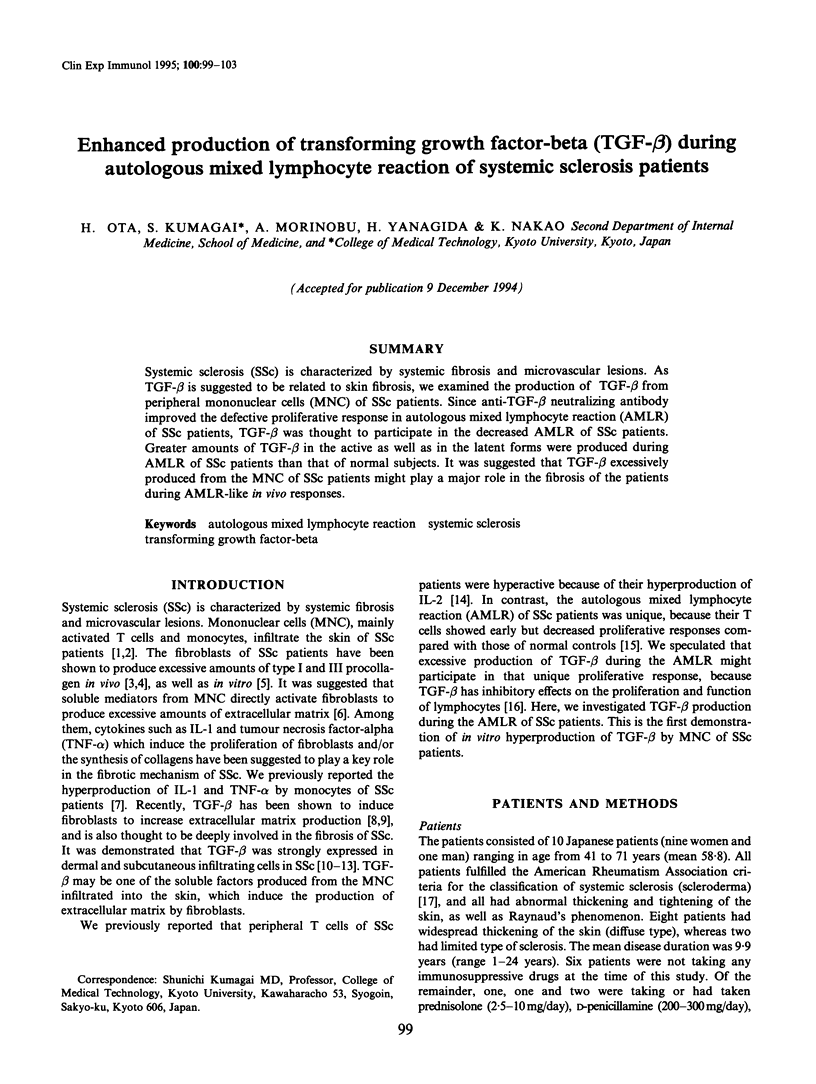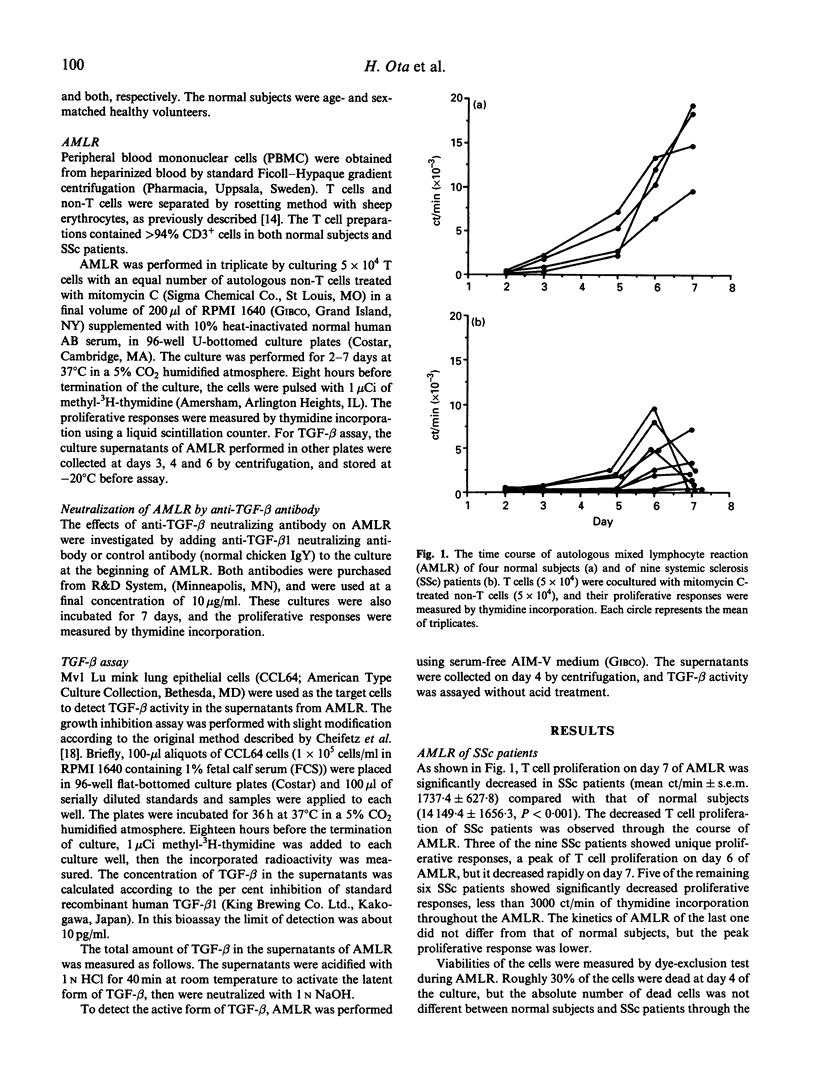Abstract
Systemic sclerosis (SSc) is characterized by systemic fibrosis and microvascular lesions. As TGF-beta is suggested to be related to skin fibrosis, we examined the production of TGF-beta from peripheral mononuclear cells (MNC) of SSc patients. Since anti-TGF-beta neutralizing antibody improved the defective proliferative response in autologous mixed lymphocyte reaction (AMLR) of SSc patients, TGF-beta was thought to participate in the decreased AMLR of SSc patients. Greater amounts of TGF-beta in the active as well as in the latent forms were produced during AMLR of SSc patients than that of normal subjects. It was suggested that TGF-beta excessively produced from the MNC of SSc patients might play a major role in the fibrosis of the patients during AMLR-like in vivo responses.
Full text
PDF




Selected References
These references are in PubMed. This may not be the complete list of references from this article.
- Alcocer-Varela J., Laffón A., Alarcón-Segovia D., Ibañez de Kasep G. Early proliferative response in the human autologous mixed lymphocyte reaction in scleroderma. J Rheumatol. 1984 Feb;11(1):48–52. [PubMed] [Google Scholar]
- AyanlarBatuman O., Ferrero A. P., Diaz A., Jimenez S. A. Regulation of transforming growth factor-beta 1 gene expression by glucocorticoids in normal human T lymphocytes. J Clin Invest. 1991 Nov;88(5):1574–1580. doi: 10.1172/JCI115469. [DOI] [PMC free article] [PubMed] [Google Scholar]
- Bristol L. A., Ruscetti F. W., Brody D. T., Durum S. K. IL-1 alpha induces expression of active transforming growth factor-beta in nonproliferating T cells via a post-transcriptional mechanism. J Immunol. 1990 Dec 15;145(12):4108–4114. [PubMed] [Google Scholar]
- Cheifetz S., Weatherbee J. A., Tsang M. L., Anderson J. K., Mole J. E., Lucas R., Massagué J. The transforming growth factor-beta system, a complex pattern of cross-reactive ligands and receptors. Cell. 1987 Feb 13;48(3):409–415. doi: 10.1016/0092-8674(87)90192-9. [DOI] [PubMed] [Google Scholar]
- Fleischmajer R., Gay S., Meigel W. N., Perlish J. S. Collagen in the cellular and fibrotic stages of scleroderma. Arthritis Rheum. 1978 May;21(4):418–428. doi: 10.1002/art.1780210404. [DOI] [PubMed] [Google Scholar]
- Fleischmajer R., Perlish J. S., Reeves J. R. Cellular infiltrates in scleroderma skin. Arthritis Rheum. 1977 May;20(4):975–984. doi: 10.1002/art.1780200410. [DOI] [PubMed] [Google Scholar]
- Gay R. E., Buckingham R. B., Prince R. K., Gay S., Rodnan G. P., Miller E. J. Collagen types synthesized in dermal fibroblast cultures from patients with early progressive systemic sclerosis. Arthritis Rheum. 1980 Feb;23(2):190–196. doi: 10.1002/art.1780230209. [DOI] [PubMed] [Google Scholar]
- Gruschwitz M., Müller P. U., Sepp N., Hofer E., Fontana A., Wick G. Transcription and expression of transforming growth factor type beta in the skin of progressive systemic sclerosis: a mediator of fibrosis? J Invest Dermatol. 1990 Feb;94(2):197–203. doi: 10.1111/1523-1747.ep12874503. [DOI] [PubMed] [Google Scholar]
- Kehrl J. H., Wakefield L. M., Roberts A. B., Jakowlew S., Alvarez-Mon M., Derynck R., Sporn M. B., Fauci A. S. Production of transforming growth factor beta by human T lymphocytes and its potential role in the regulation of T cell growth. J Exp Med. 1986 May 1;163(5):1037–1050. doi: 10.1084/jem.163.5.1037. [DOI] [PMC free article] [PubMed] [Google Scholar]
- Kulozik M., Hogg A., Lankat-Buttgereit B., Krieg T. Co-localization of transforming growth factor beta 2 with alpha 1(I) procollagen mRNA in tissue sections of patients with systemic sclerosis. J Clin Invest. 1990 Sep;86(3):917–922. doi: 10.1172/JCI114793. [DOI] [PMC free article] [PubMed] [Google Scholar]
- Kähäri V. M., Sandberg M., Kalimo H., Vuorio T., Vuorio E. Identification of fibroblasts responsible for increased collagen production in localized scleroderma by in situ hybridization. J Invest Dermatol. 1988 May;90(5):664–670. doi: 10.1111/1523-1747.ep12560826. [DOI] [PubMed] [Google Scholar]
- Li B., Sehajpal P. K., Khanna A., Vlassara H., Cerami A., Stenzel K. H., Suthanthiran M. Differential regulation of transforming growth factor beta and interleukin 2 genes in human T cells: demonstration by usage of novel competitor DNA constructs in the quantitative polymerase chain reaction. J Exp Med. 1991 Nov 1;174(5):1259–1262. doi: 10.1084/jem.174.5.1259. [DOI] [PMC free article] [PubMed] [Google Scholar]
- Linardopoulos S., Corrigall V., Panayi G. S. Activation of HLA-DR and interleukin-6 gene transcription in resting T cells via the CD2 molecule: relevance to chronic immune-mediated inflammation. Scand J Immunol. 1992 Sep;36(3):469–477. doi: 10.1111/j.1365-3083.1992.tb02962.x. [DOI] [PubMed] [Google Scholar]
- Roberts A. B., Sporn M. B., Assoian R. K., Smith J. M., Roche N. S., Wakefield L. M., Heine U. I., Liotta L. A., Falanga V., Kehrl J. H. Transforming growth factor type beta: rapid induction of fibrosis and angiogenesis in vivo and stimulation of collagen formation in vitro. Proc Natl Acad Sci U S A. 1986 Jun;83(12):4167–4171. doi: 10.1073/pnas.83.12.4167. [DOI] [PMC free article] [PubMed] [Google Scholar]
- Roumm A. D., Whiteside T. L., Medsger T. A., Jr, Rodnan G. P. Lymphocytes in the skin of patients with progressive systemic sclerosis. Quantification, subtyping, and clinical correlations. Arthritis Rheum. 1984 Jun;27(6):645–653. doi: 10.1002/art.1780270607. [DOI] [PubMed] [Google Scholar]
- Scharffetter K., Lankat-Buttgereit B., Krieg T. Localization of collagen mRNA in normal and scleroderma skin by in-situ hybridization. Eur J Clin Invest. 1988 Feb;18(1):9–17. doi: 10.1111/j.1365-2362.1988.tb01158.x. [DOI] [PubMed] [Google Scholar]
- Umehara H., Kumagai S., Ishida H., Suginoshita T., Maeda M., Imura H. Enhanced production of interleukin-2 in patients with progressive systemic sclerosis. Hyperactivity of CD4-positive T cells? Arthritis Rheum. 1988 Mar;31(3):401–407. doi: 10.1002/art.1780310312. [DOI] [PubMed] [Google Scholar]
- Umehara H., Kumagai S., Murakami M., Suginoshita T., Tanaka K., Hashida S., Ishikawa E., Imura H. Enhanced production of interleukin-1 and tumor necrosis factor alpha by cultured peripheral blood monocytes from patients with scleroderma. Arthritis Rheum. 1990 Jun;33(6):893–897. doi: 10.1002/art.1780330619. [DOI] [PubMed] [Google Scholar]
- Worrall J. G., Whiteside T. L., Prince R. K., Buckingham R. B., Stachura I., Rodnan G. P. Persistence of scleroderma-like phenotype in normal fibroblasts after prolonged exposure to soluble mediators from mononuclear cells. Arthritis Rheum. 1986 Jan;29(1):54–64. doi: 10.1002/art.1780290108. [DOI] [PubMed] [Google Scholar]


